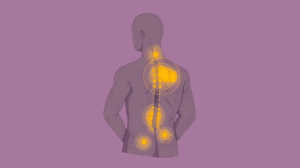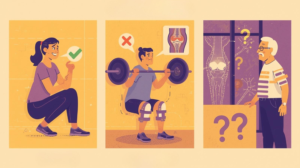Knee pain is the most common complaint across all age groups affecting athletes, elderly individuals and people recovering from injury or surgery. With rising awareness of knee health, knee caps (braces or sleeves) have become a popular choice for providing support, pain relief and injury prevention.
A common question many people have is “ How long should I wear a kneecap?” While kneecaps can be highly beneficial, overuse or improper use can lead to muscle weakness, skin irritation, reduced circulation, and even joint dependency [1]. Understanding the proper duration and usage is essential for safe and effective support.
This article explores:
- How a kneecap functions
- The benefits and risks of wearing it
- Expert guidelines on safe duration
- Practical tips for effective use
What a Kneecap Does
A kneecap, also known as a knee brace, support, or sleeve, is an external device designed to support, stabilize, and protect the knee joint. It is commonly used by athletes, elderly individuals, and people recovering from injury or surgery. By providing mechanical support to the joint, kneecaps help reduce pain, swelling, and the risk of further injury.
Key Functions
- Compression:
- Kneecaps apply gentle compression around the joint.
- This helps reduce inflammation, swelling, and fluid accumulation, particularly after minor injuries or during flare-ups of arthritis.
- Compression also improves blood circulation, promoting faster recovery.
- Support and Stability:
- Kneecaps stabilize the ligaments, tendons, and surrounding muscles, preventing excessive or abnormal movement.
- For people with weak knees, previous injuries, or post-surgical conditions, this support is crucial in preventing re-injury or joint strain.
- Pain Reduction:
- By distributing pressure evenly and stabilizing the joint, knee caps can alleviate pain caused by arthritis, tendonitis, sprains, or general joint discomfort.
- Warming the joint through the sleeve’s material also reduces stiffness and improves comfort during movement.
- Confidence in Movement:
- Wearing a kneecap allows individuals to perform daily activities or exercise without fear of sudden knee buckling or instability.
- This mental reassurance often encourages more active lifestyles, which in turn supports long-term joint health.
Types of Kneecaps

Knee caps, or knee braces, come in several varieties, each designed to address specific needs ranging from minor discomfort to post-surgical recovery. Choosing the right type is crucial to ensure effective support, pain relief, and injury prevention.
1. Compression Sleeves
- Description:
Compression sleeves are made from stretchable materials such as neoprene, spandex, or elastic fabric. They fit snugly around the knee joint, providing gentle, uniform compression.
- Primary Function:
- Reduces swelling and fluid accumulation by improving circulation.
- Provides mild support to ligaments, tendons, and surrounding muscles.
- Maintains warmth around the joint, helping reduce stiffness and soreness.
- Ideal Use:
- People with minor knee pain, mild arthritis, or post-exercise soreness.
- Suitable for everyday activity, walking, or low-impact workouts.
- Benefits:
- Lightweight and flexible, allowing natural movement.
- Easy to wear for extended periods without causing discomfort.
- Can be used preventively during physical activity to avoid strain [2].
2. Hinged Braces
- Description:
Hinged braces incorporate metal or plastic hinges along the sides of the knee. These hinges provide rigid lateral support, preventing unwanted side-to-side movement.
- Primary Function:
- Stabilizes the knee in cases of ligament injuries, such as ACL, MCL, or LCL tears.
- Controls knee flexion and extension, making it safer to perform movement during rehabilitation.
- Reduces the risk of re-injury during high-impact activities.
- Ideal Use:
- Post-surgery patients who need controlled joint movement.
- Athletes recovering from ligament injuries.
- Individuals with severe instability due to previous trauma.
- Benefits:
- Offers maximum structural support to the knee joint.
- Allows safe rehabilitation exercises without compromising recovery.
- Reduces anxiety associated with unstable or weak knees.
3. Patellar Stabilizers
- Description:
Patellar stabilizers are specialized braces designed to keep the kneecap (patella) aligned during movement. They often include padding or straps around the patella to maintain proper tracking.
- Primary Function:
- Prevents the kneecap from sliding out of place, which is common in patellar tracking disorders.
- Reduces stress on the surrounding ligaments and tendons, preventing pain and inflammation.
- Ideal Use:
- Individuals with chronic knee instability or patellofemoral pain syndrome.
- Athletes prone to kneecap dislocation or subluxation.
- People experiencing pain around the kneecap during daily activities or exercise.
- Benefits:
- Enhances knee alignment and movement control.
- Helps prevent recurring dislocations or injuries.
- Lightweight design allows comfortable long-term wear [3].
4. Post-Surgery Immobilizers
- Description:
Post-surgery immobilizers are braces that restrict knee movement to promote healing after procedures such as ACL reconstruction, meniscus repair, or tendon surgery. They are often adjustable to control the range of motion.
- Primary Function:
- Protects the knee during the critical recovery phase.
- Limits flexion and extension to prevent strain on healing tissues.
- Maintains joint alignment and stability.
- Ideal Use:
- Individuals immediately after knee surgery.
- Patients require immobilization for several weeks during the healing process.
- Benefits:
- Provides maximum protection, reducing the risk of complications.
- Adjustable settings allow gradual increase in mobility under medical supervision.
- Supports safe rehabilitation, preventing accidental movements that could disrupt recovery.
Effectiveness Depends on Condition
The benefits and safe duration of knee cap use depend on individual conditions:
- Injury Type: Sprains, ligament tears, or post-surgical needs may require longer wear.
- Arthritis Severity: Chronic knee pain may need intermittent support during activity.
- Daily Activity Levels: Active individuals may use knee caps during workouts, while sedentary users may only require them during pain episodes [4].
Benefits of Wearing a Knee Cap
Wearing a knee cap offers numerous advantages, ranging from immediate pain relief to long-term injury prevention. Understanding these benefits helps users maximize the effectiveness of their knee support.
1. Pain Relief and Comfort
- Kneecaps reduce joint strain by distributing pressure evenly across the knee.
- They alleviate pain caused by arthritis, tendonitis, or minor injuries.
- Maintaining warmth in the joint reduces stiffness, making it easier to move and perform daily tasks.
2. Injury Prevention
- Provides external stabilization, preventing twisting, overextension, or sudden lateral movements.
- Essential for athletes and physically active individuals during sports or workouts.
- Reduces the risk of ligament injuries in people with weak or previously injured knees.
3. Post-Surgery or Injury Support
- Kneecaps are prescribed to protect the joint while tissues heal after surgery or injury.
- Prevents accidental movements that may delay recovery.
- Ensures safe rehabilitation by allowing controlled mobility.
4. Improved Mobility and Confidence
- Wearing a kneecap provides mental reassurance, allowing individuals to move more confidently.
- Supports balance and stability, especially during walking, running, or climbing stairs.
- Encourages active participation in daily life, preventing sedentary behavior that could worsen muscle weakness.
Risks of Wearing a Knee Cap Too Long
Despite the benefits, prolonged or improper use of a knee cap can pose risks:
1. Skin Irritation
- Extended wear can lead to redness, itching, or rashes, especially if the material traps sweat.
- Allergic reactions may occur in sensitive individuals due to latex or synthetic fabrics.
- Moisture accumulation increases the risk of fungal or bacterial infections.
2. Reduced Circulation
- A kneecap that is too tight can restrict blood flow.
- Symptoms include tingling, numbness, swelling, or cold sensations in the leg.
- Poor circulation may exacerbate knee problems over time if left unchecked [5].
3. Muscle Weakness
- Continuous support reduces the need for surrounding muscles to stabilize the joint.
- Quadriceps, hamstring, and calf muscles may weaken, making the knee dependent on external support.
4. Restricted Joint Flexibility and Psychological Dependence
- Overuse may reduce natural joint flexibility.
- Some individuals may rely psychologically on the brace, avoiding natural movement even when it’s safe.
Expert Guidelines on Duration
The safe duration of wearing a knee cap depends on activity level, knee condition, and medical advice. Here’s a detailed breakdown:
1. During Physical Activity
- Recommended for workouts, sports, or heavy physical tasks.
- Provides support during knee-intensive movements, such as running, squats, or jumping.
- Remove after activity to allow muscles to function independently.
2. Post-Injury or Post-Surgery
- Extended wear may be prescribed temporarily to aid recovery.
- Typically involves wearing a brace during walking, physiotherapy exercises, or daily activities for 2–6 weeks depending on injury severity.
- Follow doctor or physiotherapist instructions regarding exact duration.
3. Everyday Use for Healthy Knees
- Only necessary during pain episodes or heavy physical exertion.
- Healthy knees do not require all-day wear, and prolonged use may cause more harm than benefit.
4. Fit and Snugness Matter
- The kneecap should be snug but not overly tight.
- Remove periodically, especially if tingling, numbness, or discomfort occurs.
- Avoid wearing while sleeping unless medically prescribed.
5. Gradual Adjustment
- Start with short durations (1–2 hours), then gradually increase if needed.
- Combine with strengthening exercises to improve natural knee stability.
- Monitor response and discontinue if any adverse effects appear.
Tips for Safe and Effective Use
1. Choosing the Right Type and Size
- Compression sleeves for general pain and mild support.
- Hinged braces for severe instability or ligament injuries.
- Ensure sizing follows the manufacturer’s guidelines; too tight causes circulation issues, and too loose reduces effectiveness.
2. Take Regular Breaks
- Remove the kneecap every 2–3 hours during extended wear.
- Let skin breathe and muscles function naturally.
- Avoid continuous use if not medically necessary.
3. Maintain Hygiene
- Wash the kneecap regularly according to manufacturer instructions.
- Dry thoroughly to prevent bacterial or fungal infections.
4. Combine with Strengthening Exercises
- Integrate exercises such as:
- Squats: strengthen quadriceps and glutes.
- Leg Raises: target lower leg and knee-supporting muscles.
- Hamstring Stretches: improve flexibility and reduce strain.
- Regular exercise reduces dependence on the brace over time.
5. Avoid Sleeping with the Knee Cap
- Restricts movement and reduces blood circulation during rest.
- Only wear at night if specifically prescribed by a healthcare professional.
Conclusion
Knee caps are a valuable tool for pain relief, injury prevention and post surgical recovery.
They reduce strain, improve stability and provide mental reassurance during movement. However, improper use can lead to skin issues, circulation problems and muscle weakness. Understanding the safe duration, fit and purpose is crucial.
By combining proper usage with strengthening exercise and adjusting lifestyle, individuals can enjoy the benefits of kneecaps without risking complications.
Looking for more health and wellness solutions ? Don’t miss these related guides:-
Frequently Asked Questions:
1. How long is it safe to wear a kneecap each day?
Generally, 1–3 hours for mild support or during activity is sufficient. Post-injury or post-surgery, follow medical advice. Avoid all-day continuous wear unless prescribed.
2. Can I sleep while wearing a knee cap?
Not recommended unless instructed by a doctor. Sleeping with a brace may reduce circulation and cause stiffness.
3. Does wearing a kneecap too long weaken knee muscles?
Yes, prolonged reliance can reduce quadriceps and hamstring strength, leading to dependency and joint instability.
4. When should I wear a knee cap for injury recovery?
During daily activities, physiotherapy exercises, or walking, as advised by a physiotherapist or surgeon. Remove during rest or periods of minimal activity.
5. How tight should a knee brace be for daily use?
Snug enough to provide support but not tight enough to cause numbness, tingling, or swelling.
References
- American Academy of Orthopaedic Surgeons. (2024). Knee pain and knee braces: Types and usage. https://orthoinfo.aaos.org
- Cleveland Clinic. (2023). Knee support: Benefits, types, and usage guidelines. https://my.clevelandclinic.org
- Harvard Health Publishing. (2023). When and how to wear knee braces. https://www.health.harvard.edu
- Mayo Clinic. (2024). Knee pain: Treatment and prevention. https://www.mayoclinic.org
- National Institute of Arthritis and Musculoskeletal and Skin Diseases. (2023). Knee health and support devices. https://www.niams.nih.gov























